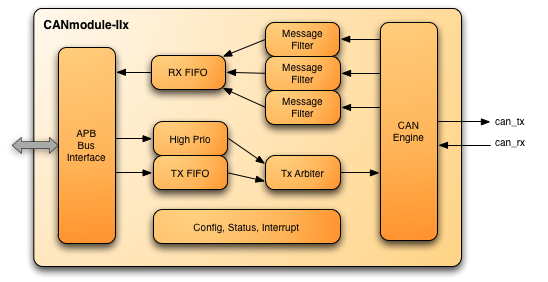CANmodule-IIx
FIFO based CAN Controller
CANmodule-IIx is a full functional CAN controller module that contains advanced message filtering, and receive-, and transmit buffers. It is designed to provide a low gate-count CAN interface for FPGA and ASIC based system-on-chip (SOC) integrations.
Full message filtering together with a transmit FIFO and a high priority transmit message buffer support a wide range of applications. An AMBA Advanced Peripheral Bus (APB) interface enables smooth integration into ARM based SOC’s.
Block Diagram

Features
Standard Compliant
- Full CAN 2.0A/B compliant
- ISO 11898-1 compatible
- Supports standard CAN baud rates including 1 Mbps
Receive Path
- 3 fully programmable message filters
- Each message filter covers: ID, IDE, RTR, data byte 1 and data byte 2
- 32 messages deep receive FIFO
- FIFO status indicator
- Message received time-stamp
Transmit Path
- 16 messages deep transmit FIFO
- 1 message buffer for high priority messages to bypass transmit FIFO
- Message Arbiter
System Bus Interface
- AMBA 2.0 Advanced Peripheral Bus Interface
- Other bus interfaces available upon request
- 8-bit, 16-bit, or 32-bit wide data path
- Status and configuration interface
Programmable Interrupt Controller
- Local interrupt controller covering message and CAN error sources
Target for FPGA Implementations
- Supports FPGA systems with two clock domains
- System clock (fast clock)
- CAN clock (slow clock, multiple of 8MHz)
Test and Debug Support
- Listen only mode
- Internal loopback mode
- External loopback mode
SRAM Based Message Buffers
- Optimized for low gate-count implementation
- 100% Synchronous Design
Implementation Options
The core can be configured for your application to get a gate-count optimized implementation:
- Configurations readback enable
- Separate clock domains for CAN and system clock
- Fixed CAN configuration
- Selectable number of message filters: 0, 1, 2, or 3
- Data bus width: 8, 16, or 32-bit
Highlights
- Low-level CAN protocol engine
- Message buffers and filters are application specific add-ons
- Register based
- Technology independent